oil change CHEVROLET VEGA 1976 1.G Owners Manual
[x] Cancel search | Manufacturer: CHEVROLET, Model Year: 1976, Model line: VEGA, Model: CHEVROLET VEGA 1976 1.GPages: 87, PDF Size: 32.36 MB
Page 15 of 87
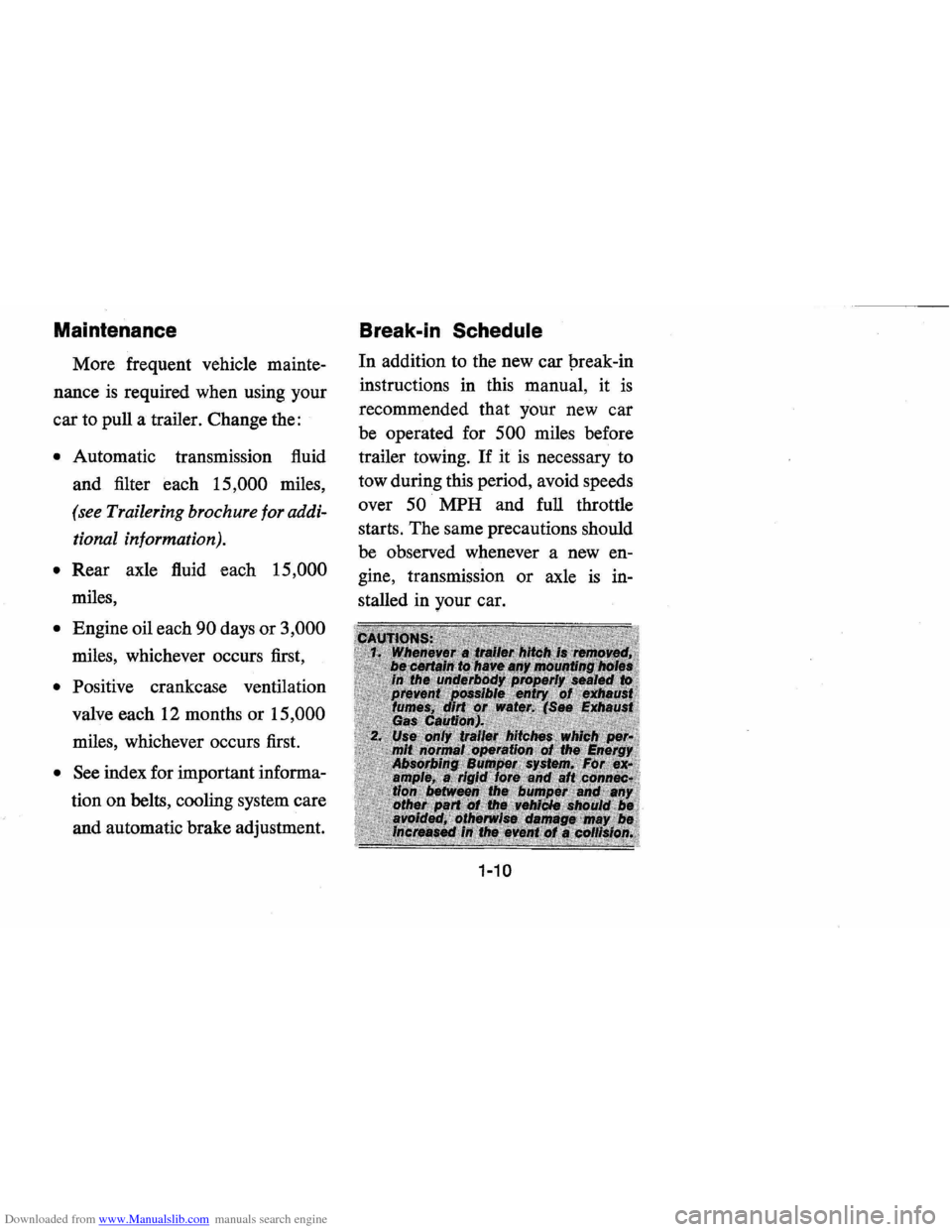
Downloaded from www.Manualslib.com manuals search engine Maintenance
More frequent vehicle mainte
nance
is required when using your
car to pull a trailer. Change the:
• Automatic transmission fluid
and filter each
15,000 miles,
(see Trailering brochure for addi
tional information).
• Rear axle fluid each 15,000
miles,
• Engine oil each 90 days or 3,000
miles, whichever occurs first,
• Positive crankcase ventilation
valve each
12 months or 15,000
miles, whichever occurs first.
• See index for important informa
tion on belts, cooling system care
and automatic brake adjustment.
Break-in Schedule
In addition to the new car preak-in
instructions in this manual, it is
recommended that your new car
be operated for
500 miles before
trailer towing.
If it is necessary to
tow during this period, avoid speeds
over
50 MPH and full throttle
starts. The same precautions should
be observed whenever a new en
gine, transmission or axle
is in
stalled in your car.
1-10
Page 52 of 87
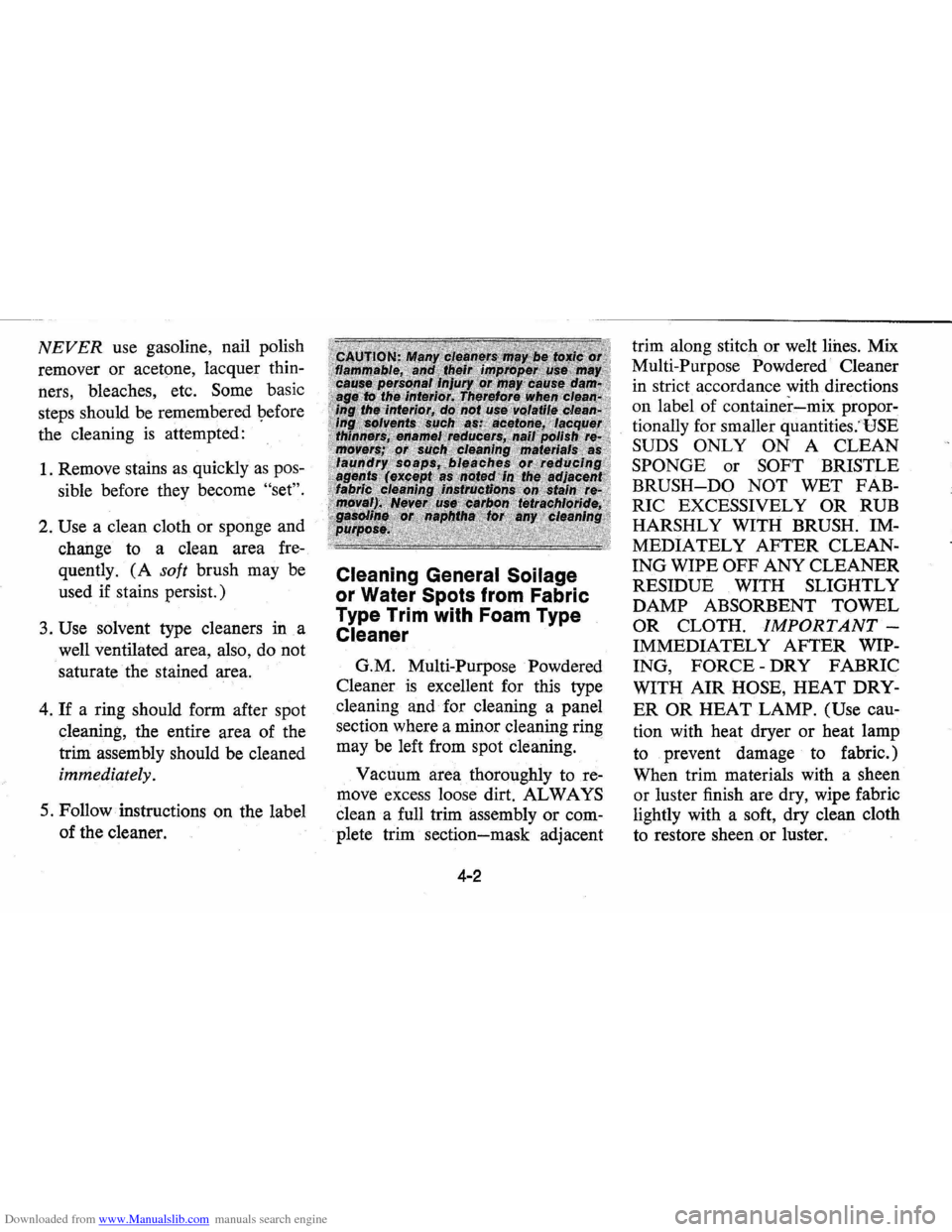
Downloaded from www.Manualslib.com manuals search engine NEVER use gasoline, nail polish
remover or acetone, lacquer
thin
ners, bleaches, etc. Some basic
steps should be remembered
l;>efore
the cleaning is attempted:
1. Remove stains as. quickly as pos
sible before they become "set".
2. Use a clean cloth or sponge and
change to a clean area
fre
quently. (A soft brush may be
used if stains persist.)
3. Use solvent type cleaners in a
well ventilated area, also, do not
saturate the stained area.
4.
If a ring should form after spot
cleaning, the entire area of the
trim assembly should be cleaned
immediately.
5. Follow instructions on the label
of the cleaner.
Cleaning General Soilage
or Water Spots from Fabric
Type Trim with Foam Type
Cleaner
G.M. Multi-Purpose Powdered
Cleaner
is excellent for this type
cleaning and for cleaning a panel
section where a minor cleaning ring
may be left from spot cleaning.
Vacuum area thoroughly to
re
move excess loose dirt. ALWAYS
clean a full trim assembly or com
plete trim section-mask adjacent
4-2
trim along stitch or welt liiles. Mix
Multi-Purpose Powdered Cleaner
in strict accordance with directions
on label of container
___ mix propor-
tionally for smaller
quantities/USE
SUDS ONLY ON A CLEAN
SPONGE or SOFT BRISTLE
BRUSH-DO NOT
WET FAB
RIC EXCESSIVELY OR RUB
HARSHL
Y WITH BRUSH. IM
MEDIATELY AFTER CLEAN
ING WIPE OFF ANY CLEANER
RESIDUE WITH SLIGHTLY
DAMP ABSORBENT TOWEL
OR CLOTH.
IMPORTANT
IMMEDIATELY AFTER WIP
ING, FORCE -DRY FABRIC
WITH AIR
HOSE, HEAT DRY
ER OR HEAT LAMP. (Use cau
tion with heat dryer or heat lamp
to prevent damage to fabric. )
When trim materials with a sheen
or luster finish are dry, wipe fabric
lightly with a soft, dry clean cloth
to restore sheen or luster.
Page 60 of 87
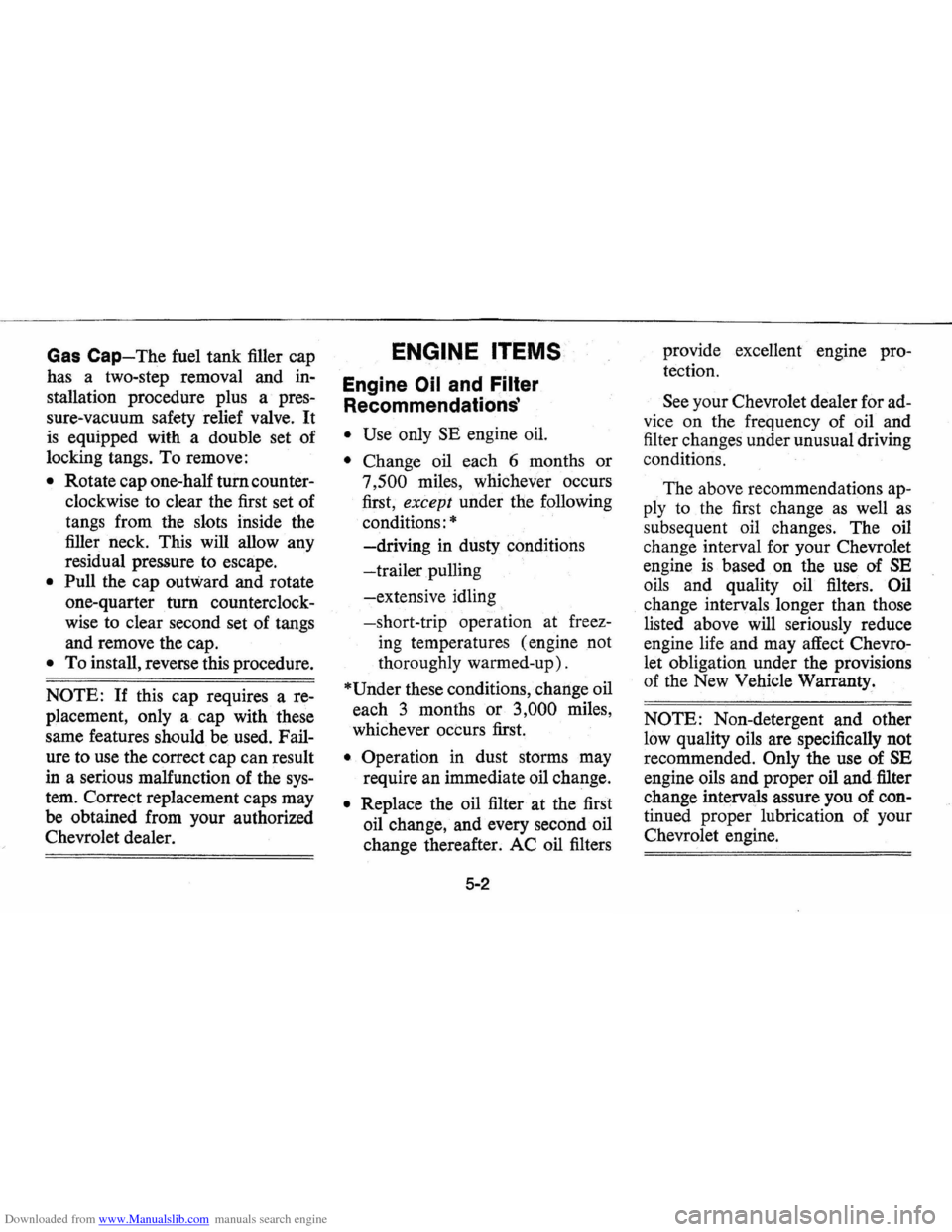
Downloaded from www.Manualslib.com manuals search engine Gas Cap-The fuel tank filler cap
has a
two-step removal and in
stallation procedure plus a pres
sure-vacuum safety relief valve. It
is equipped with a double set of
locking tangs. To remove:
• Rotate cap one-half tum counter
clockwise to clear the first set of
tangs from the slots inside the
filler neck. This will allow any
residual pressure to escape.
• Pull the cap outward and rotate
one-quarter
tum counterclock
wise to clear second set of tangs
and remove the cap.
• To install, reverse this procedure.
NOTE: If this cap requires a re
placement, only a cap with these
same features should be used.
Fail
ure to use the correct cap can result
in a serious malfunction of the
sys
tem. Correct replacement caps may
be obtained from your authorized
Chevrolet dealer.
ENGINE ITEMS
Engine Oil and Filter
Recommendations'
• Use only SE engine oil.
• Change oil each 6 months or
7,500 miles, whichever occurs
first,
except under the following
conditions:
*
-driving in dusty conditions
-trailer pulling
-extensive idling
-short-trip operation at
freez
ing temperatures (engine not
thoroughly warmed-up) .
*Under these conditions, change oil
each 3 months
or 3,000 miles,
whichever occurs first.
• Operation in dust storms may
require an immediate oil change.
• Replace the oil filter at the first
oil change, and every second oil
change thereafter. AC oil filters
5-2
provide excellent engine pro
tection.
See your Chevrolet dealer for
ad
vice on the frequency of oil and
filter changes under unusual driving
conditions.
The above recommendations
ap
ply to the first change as well as
subsequent oil changes. The oil
change interval for your Chevrolet
engine
is based on the use of SE
oils and quality oil filters.
Oil
change intervals longer than those
listed above will seriously reduce
engine life and may affect
Chevro
let obligation under the provisions
of the
New Vehicle Warranty.
NOTE: Non-detergent and other
low quality oils are specifically not
recommended.
Only the use of SE
engine oils and proper oil and filter
change intervals assure you of
con
tinued proper lubrication of your
Chevrolet engine.
Page 61 of 87
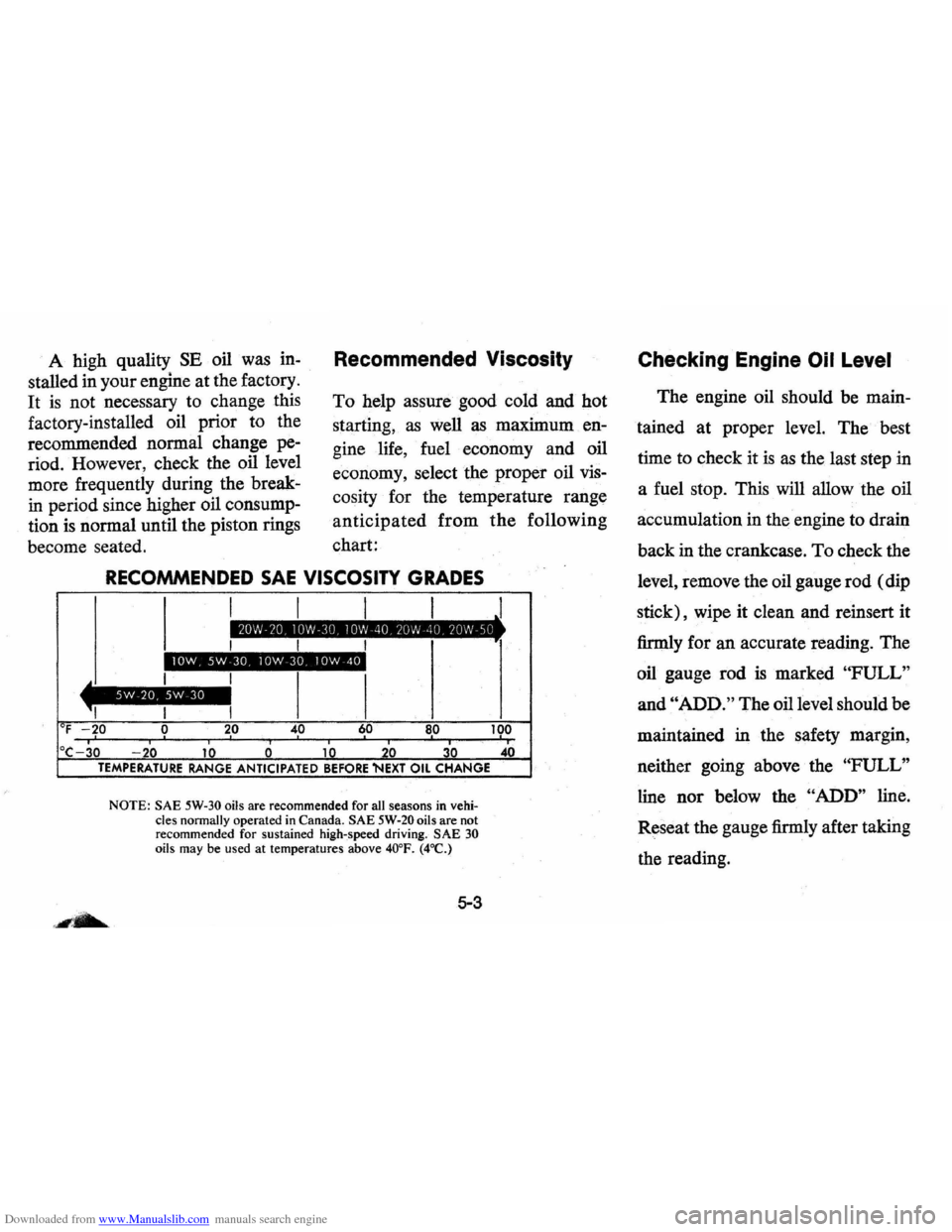
Downloaded from www.Manualslib.com manuals search engine A high quality SE oil was in
stalled in your engine at the factory.
It is not necessary to change this
factory-installed oil prior to the
recommended normal change pe
riod. However, check the oil level
more frequently during the break
in period since higher oil consump
tion
is normal until the piston rings
become seated.
Recommended Viscosity
To help assure good cold and hot
starting, .
as well as maximum en
ginelife, fuel economy and oil
economy, select the proper oil
vis
cosity for the temperature rang¥
anticipated from the following
chart:
RECOMMENDED SAE VISCOSITY GRADES
I I I I 20N 20 lOW-3~ 10N')0 2UN ·;0 20,V sc
lOW 5w 30 lOW 30 lOW 40
TEMPERATURE RANGE ANTICIPATED BEFORE 'NEXT OIL CHANGE
NOTE : SAE 5W-30 oils are recommended for all Seasons in vehicles normally operated in Canada. SAE 5W-20 oils are not
recommended for sustained high-speed driving. SAE 30 oils may be used at temperatures above 40°F. (4°C.)
5-3
100 , i 40
Checking Engine Oil Level
The engine oil should be main
tained at proper level. The best
time to check it
is as the last step in
a fuel stop. This will allow the oil
accumulation in the engine to drain
back in the crankcase. To check the
level, remove the oil gauge rod (dip
stick), wipe it clean and reinsert it
firmly for an accurate reading. The
oil gauge rod is marked "FULL"
and "ADD." The oil level should be
maintained in the safety margin,
neither going above the
"FULL"
line nor below the "ADD" line.
Reseat the gauge firmly after taking
the reading.
Page 63 of 87
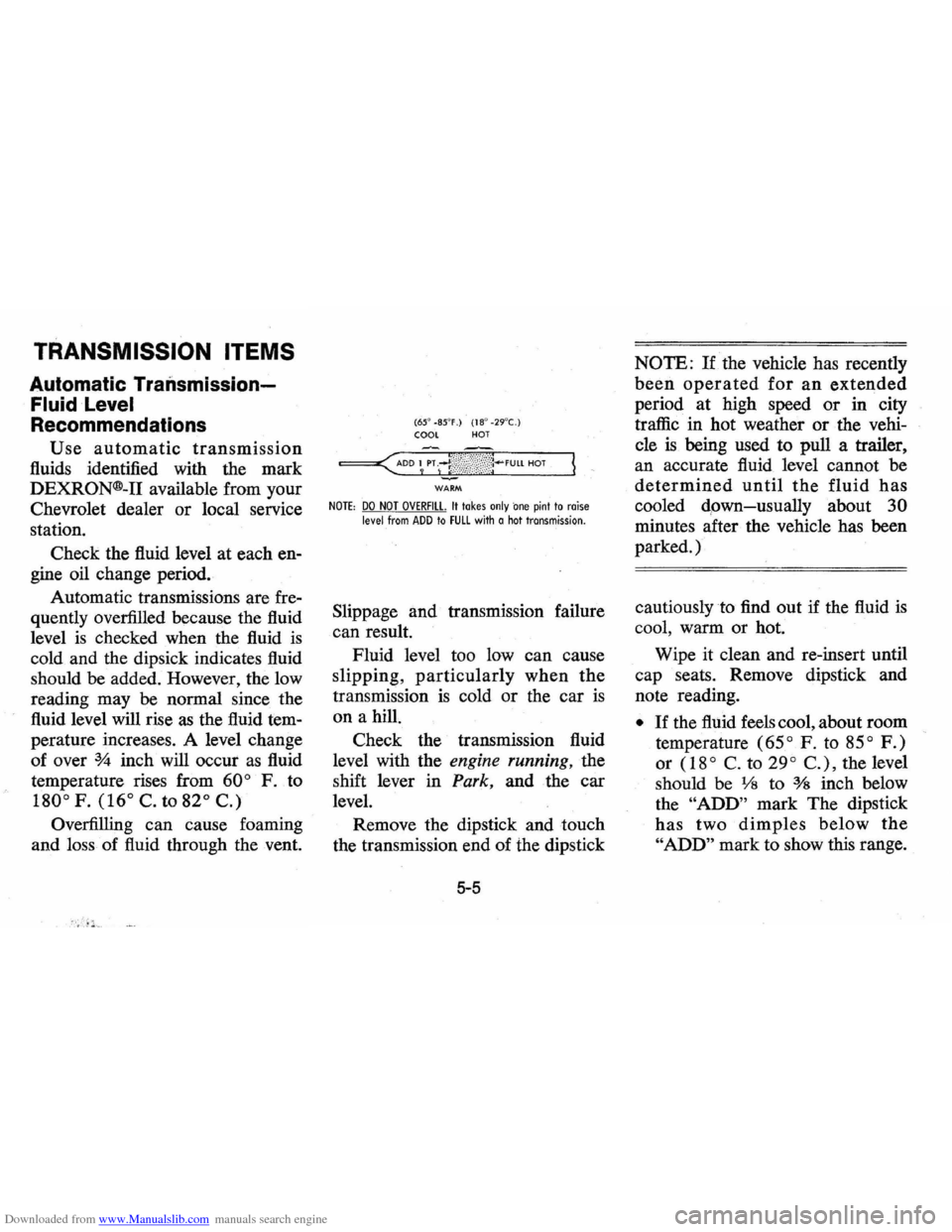
Downloaded from www.Manualslib.com manuals search engine TRANSMISSION ITEMS
Automatic Traiismission
Fluid Level
Recommendations
Use automatic transmission
fluids identified with the mark
DEXRON®-II available from your
Chevrolet dealer or local service
station.
Check the fluid level at each en
gine oil change period.
Automatic transmissions are fre
quently overfilled because the fluid
level
is checked when the fluid is
cold and the dipsick indicates fluid
should
be added. However, the low
reading may be normal since the
fluid level will rise
as the fluid tem
perature increases. A level change
of over
% inch will occur as fluid
temperature rises from
60° F. to
180° F. (16° C. to 82° C.)
Overfilling can cause foaming
and loss of fluid through the vent.
(65' -85'F .) (18 ' -29'C.) COOl HOT
WARM
NOTE: DO NOT OVERFill. It takes only 'one pint to raise level from ADD to FUll with a hot transmission.
Slippage and transmission failure
can result.
Fluid level too low can cause
slipping,
particularly when the
transmission is cold or the car is
on a hill.
Check the transmission fluid
level with the
engine running, the
shift lever in
Park, and the car
level.
Remove the dipstick and touch
the transmission end of the dipstick
NOTE: If the vehicle has recently
been operated for an extended
period at high speed or in city
traffic in hot weather
or the vehi
cle
is being used to pull a trailer,
an accurate fluid level cannot be
determined until the fluid has
cooled dpwn-usually about 30
minutes after the vehicle has been
parked.)
cautiously to find out if the fluid
is
cool, warm or hot.
Wipe it clean and re-insert until
cap seats. Remove dipstick and
note reading.
• If the fluid feels cool, about room
temperature
(65° F. to 85° F.)
or (18° C. to 29° C.), the level
should be
Vs to % inch below
the
"ADD" mark The dipstick
has two dimples below the
"ADD" mark to show this range.
Page 68 of 87
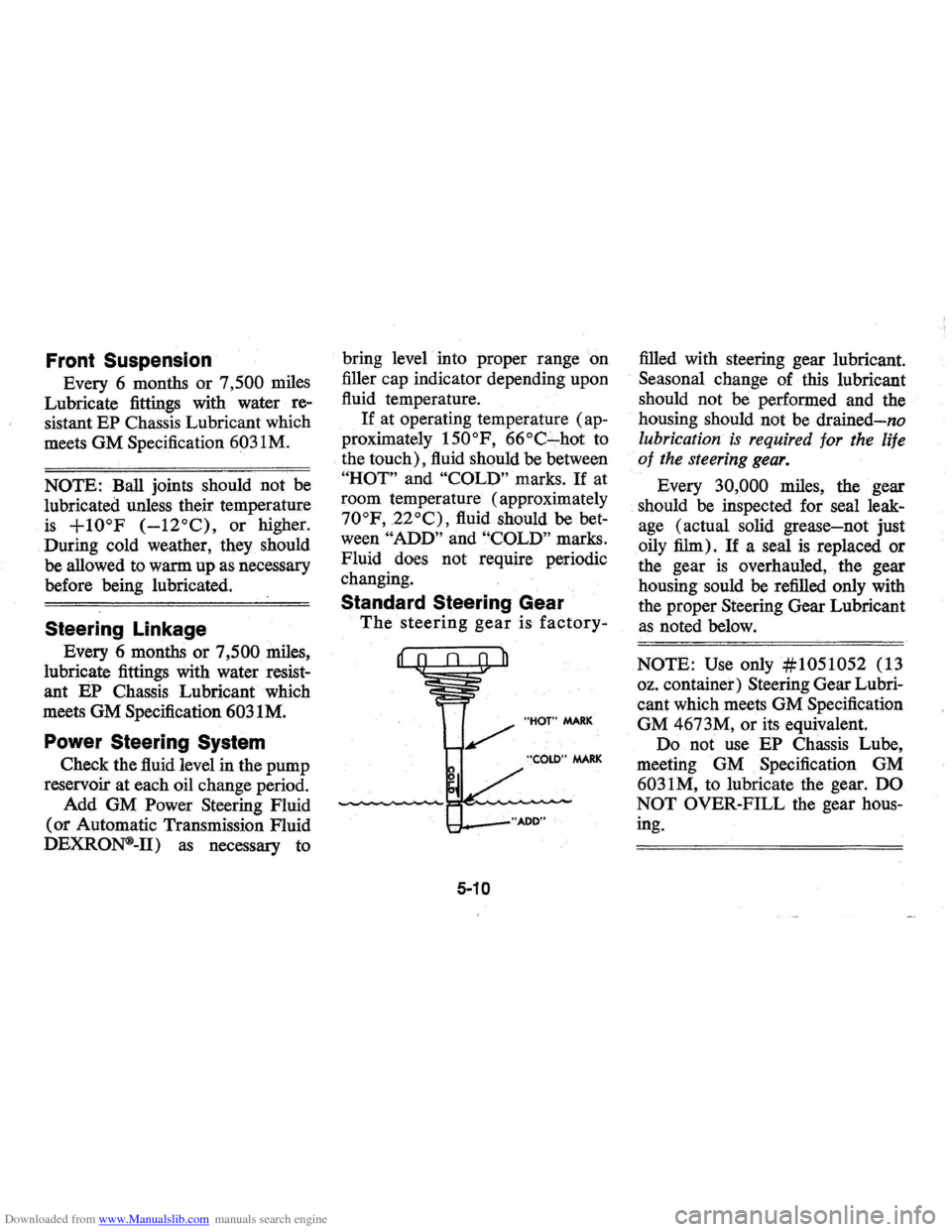
Downloaded from www.Manualslib.com manuals search engine Front Suspension
Every 6 months or 7,500 miles
Lubricate fittings with water
re
sistant EP Chassis Lubricant which
meets GM Specification
6031M.
NOTE:
Ball joints should not be
lubricated unless their temperature
is +10°F (-12°C), or higher.
During cold weather, they should
be allowed to warm up as necessary
before being lubricated.
Steering Linkage
Every 6 months or 7,500 miles,
lubricate fittings with water resist
ant
EP Chassis Lubricant which
meets GM Specification
6031M.
Power Steering System
Check the fluid level in the pump
reservoir at each oil change period.
Add GM Power Steering Fluid
(or Automatic Transmission Fluid
DEXRON®-II) as necessary to bring
level into proper range
on
filler cap indicator depending upon
fluid temperature.
If at operating temperature (ap
proximately 150°F, 66°C-hot to
the touch), fluid should be between
"HOT" and "COLD" marks. If at
room temperature (approximately
70°F, 22°C), fluid should be bet
ween "ADD" and "COLD" marks.
Fluid does not require periodic
changing.
Standard Steering Gear
The steering gear is factory-
l-t.. __ "AOO"
5-10
filled with steering gear lubricant.
Seasonal change of this lubricant
should not be performed and the
housing should not be
drained-no
lubrication is required for the life
of the steering gear.
Every 30,000 miles, the gear
should be inspected for seal leak
age (actual solid grease-not just
oily film).
If a seal is replaced or
the gear
is overhauled, the gear
housing sould be refilled only with
the proper Steering Gear Lubricant
as noted below.
NOTE: Use only #1051052 (13
oz. container) Steering Gear
Lubri
cant which meets GM Specification
GM 4673M, or its equivalent.
Do not use
EP Chassis Lube,
meeting GM Specification GM
6031M, to lubricate the gear. DO
NOT
OVER-FILL the gear hous
ing.
Page 82 of 87
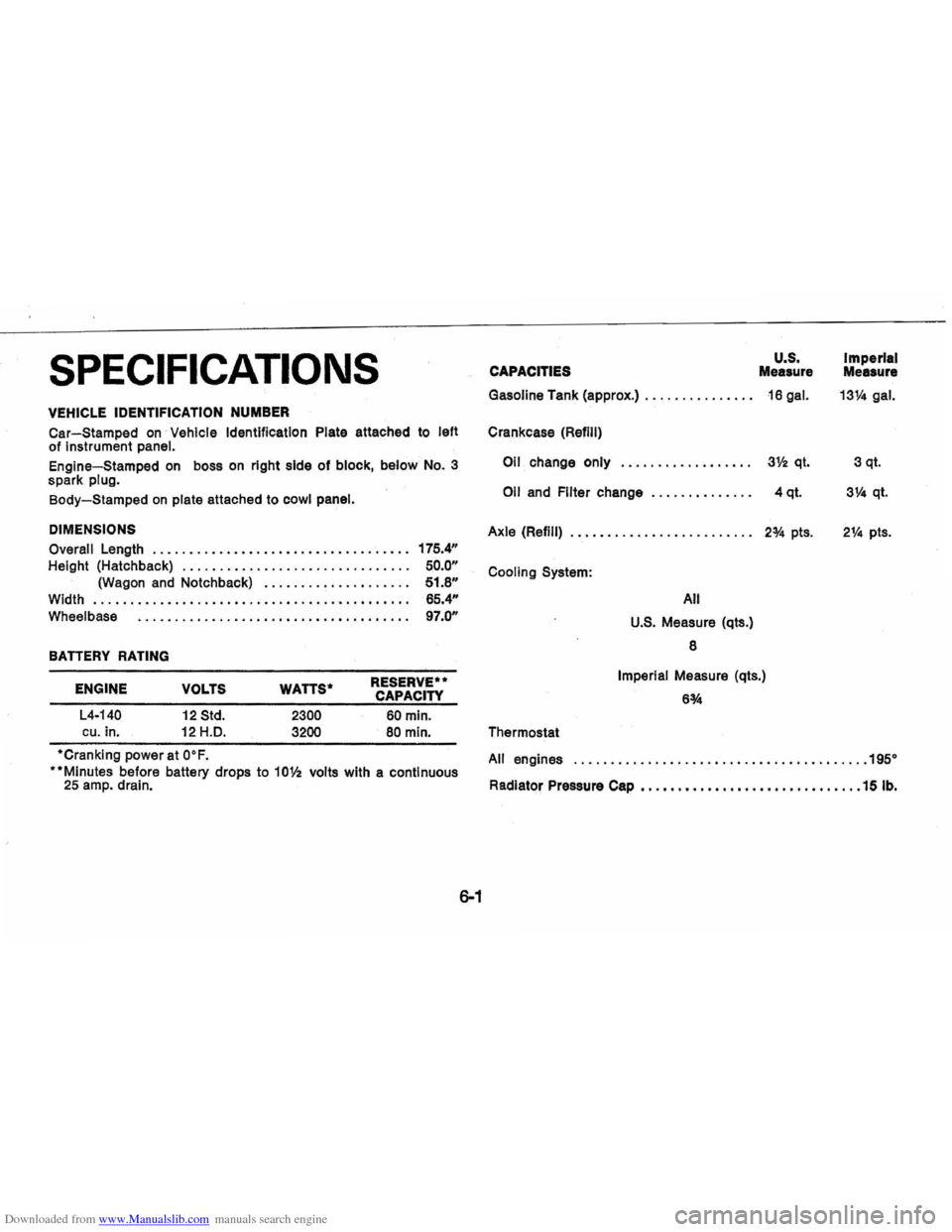
Downloaded from www.Manualslib.com manuals search engine SPECIFICATIONS
VEHICLE IDENTIFICATION NUMBER
Car-Stamped on· Vehicle Identification Plate attached to left
of Instrument panel.
Engine-Stamped
on boss on right side of block, below No. 3
spark plug.
Body-Stamped
on plate attached to cowl panel.
DIMENSIONS
Overall
Length . .........•••••.••••.•..•.•......••\
175.4"
Height (Hatchback) ............................... 50.0"
(Wagon and Notchback) ...•....•........... 51.8"
Width ..........•......••••...•.•...•..•..•.....\
. 65.4"
Wheelbase 97.0"
BATTERY RATING
ENGINE VOLTS
WATTS * RESERVE** CAPACITY
L4-140
12 Std. 2300 60 min. cu. in. 12 H.b. 3200 80 min.
'Cranking power at O°F.
"Minutes before battery drops to 10V2 volts with a continuous 25 amp. drain.
6-1
U.S. CAPACITIES Measure
Gasoline Tank (approx.) . . . . . . . . . . . .
••. 16 gal.
Crankcase
(Refill)
Oil
change only 3V2 ql.
Oil
and Filter change ..•...•....... 4 qt.
Axle (Refill) ..•.•.................... 2~ pts.
Cooling System:
Thermostat All
U.S. Measure
(qts.)
8
Imperial Measure (qts.)
6~
Imperial Measur.
13V4 gal.
3 qt.
3V4 qt.
2V4 pts.
All engines
...................•....•.........•..... 195°
Radiator Pressure Cap ••••••••••••••••••\
••••.•••.••. 15 lb.